Evaluation of the Surface Defects and Dimensional Tolerances in Multi-Hole Drilling of AA5083, AA6061, and AA2024
Abstract
1. Introduction
2. Materials and Methods
3. Results
3.1. Analysis of Hole Size Analysis and Circularity Error
3.2. Hole Cylindricity and Perpendicularity
3.3. Surface Damage Analysis
4. Discussion
5. Conclusions
Author Contributions
Funding
Institutional Review Board Statement
Informed Consent Statement
Data Availability Statement
Acknowledgments
Conflicts of Interest
Appendix A
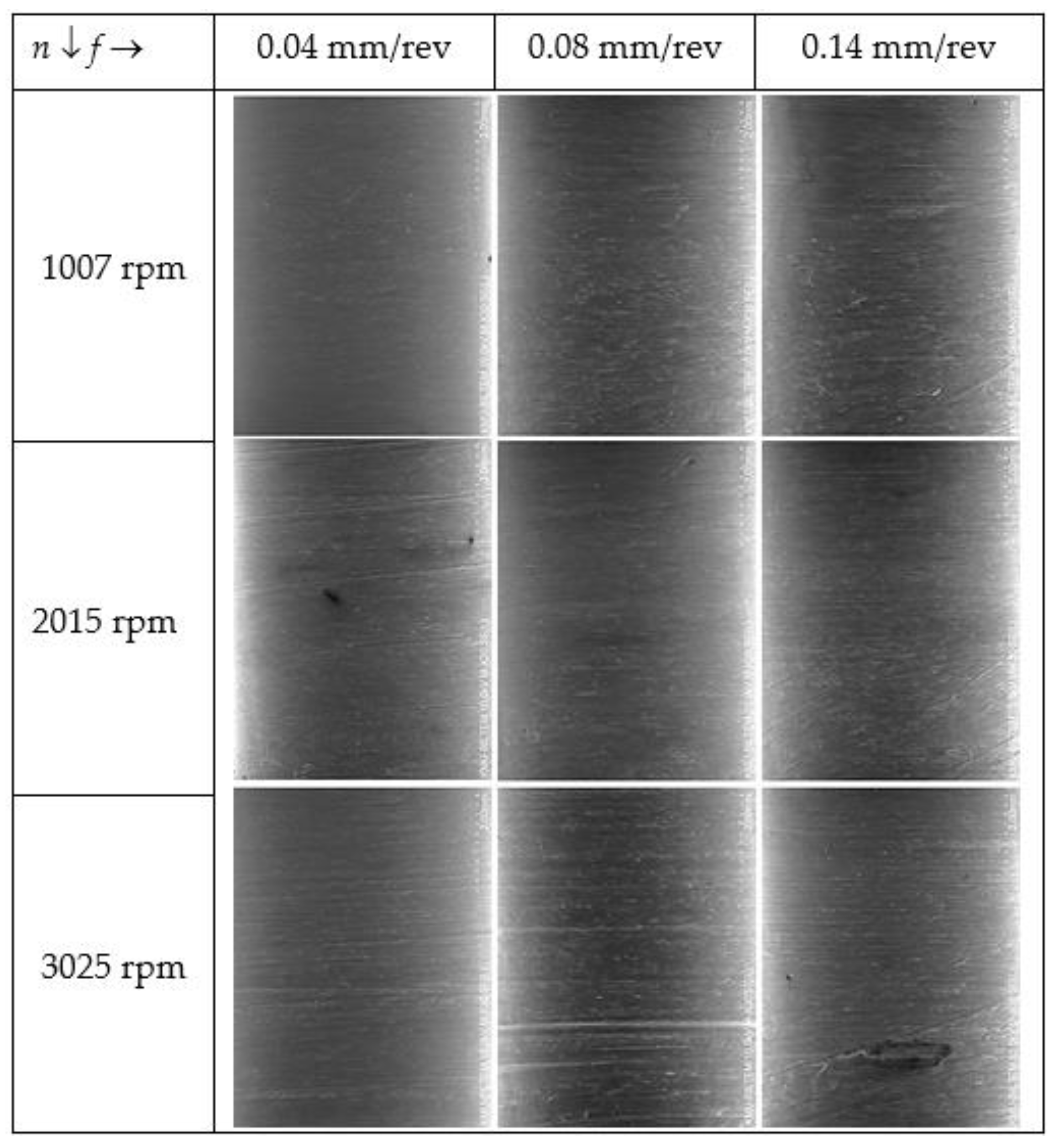
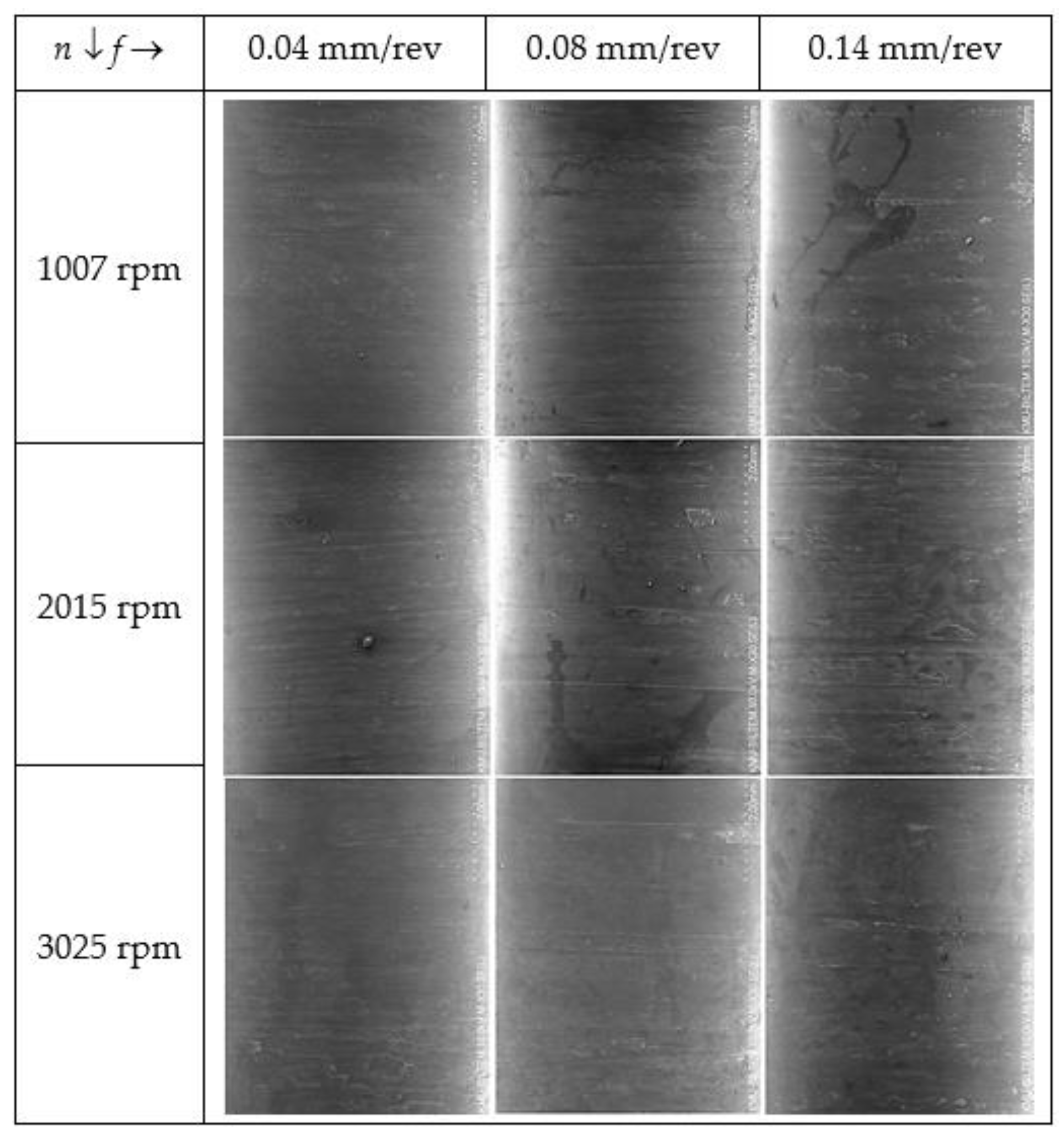
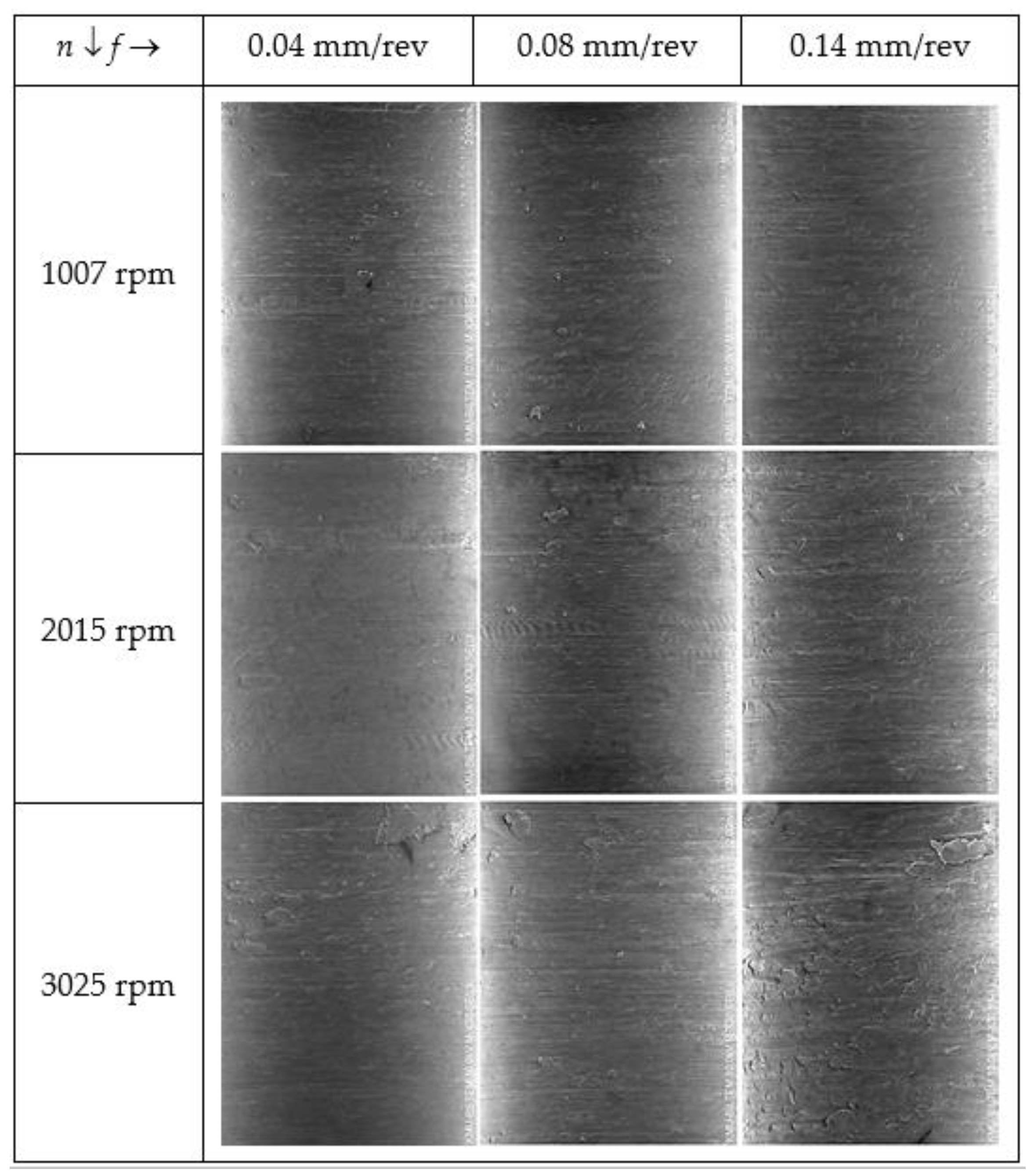
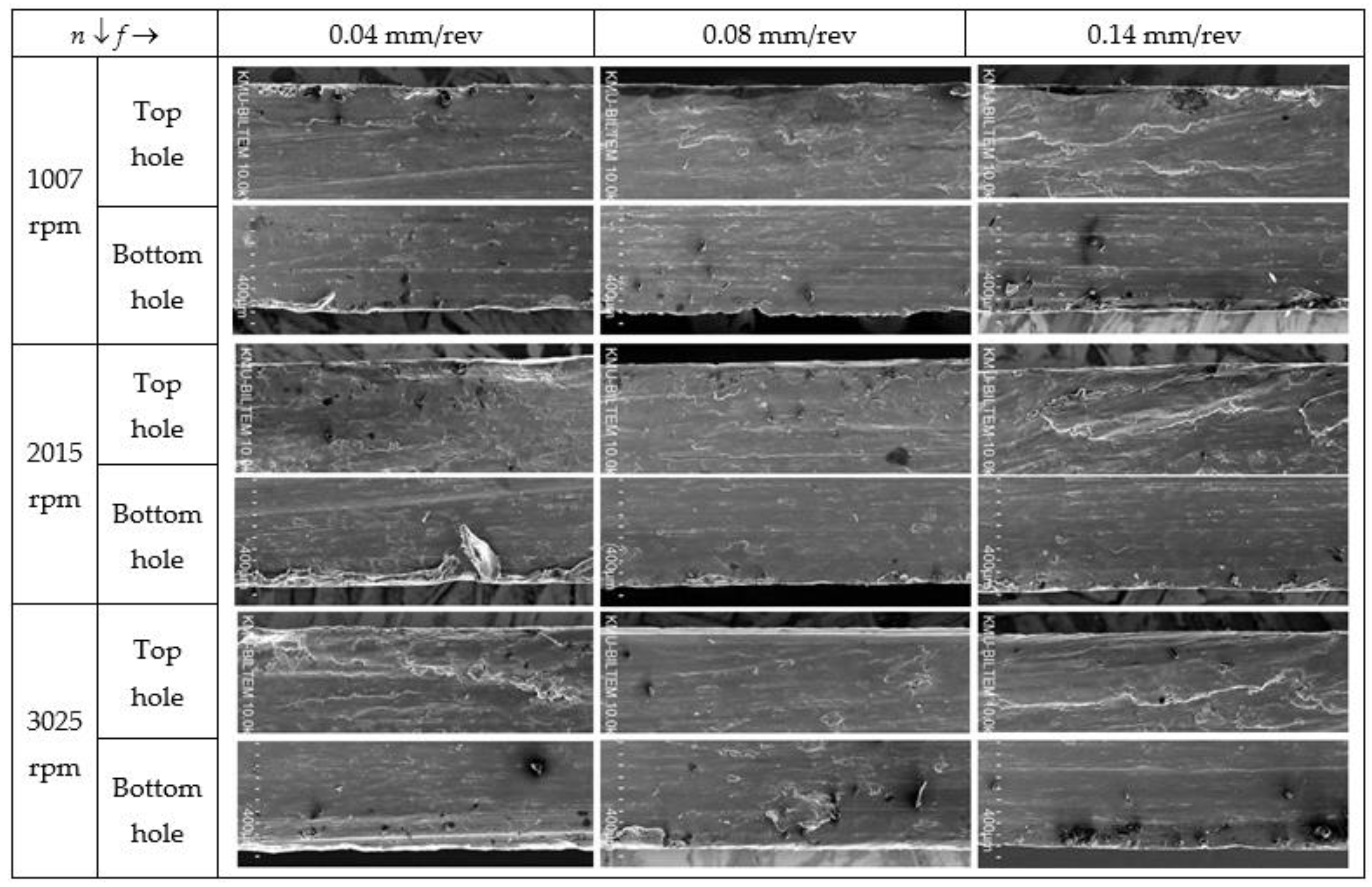
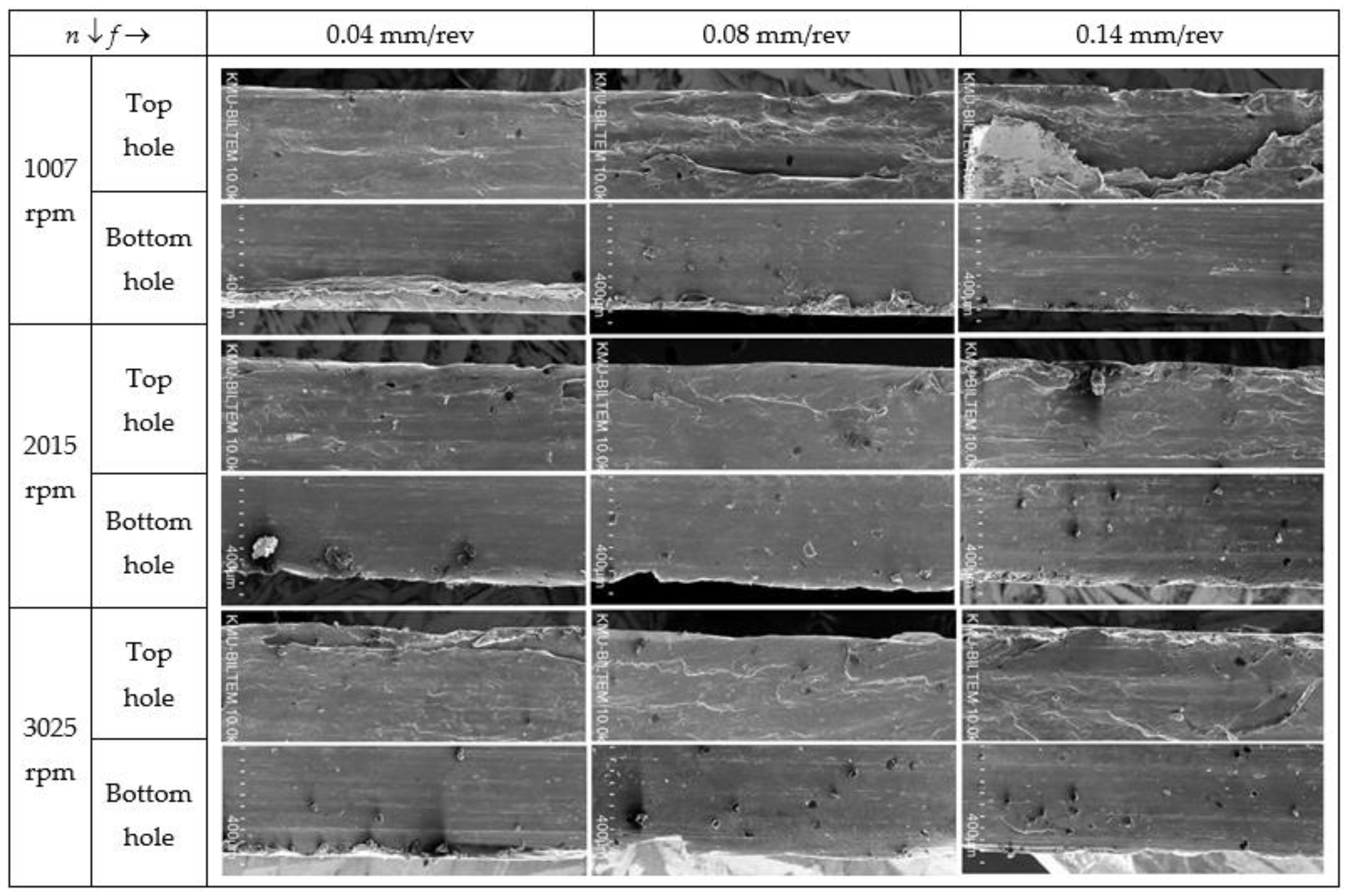
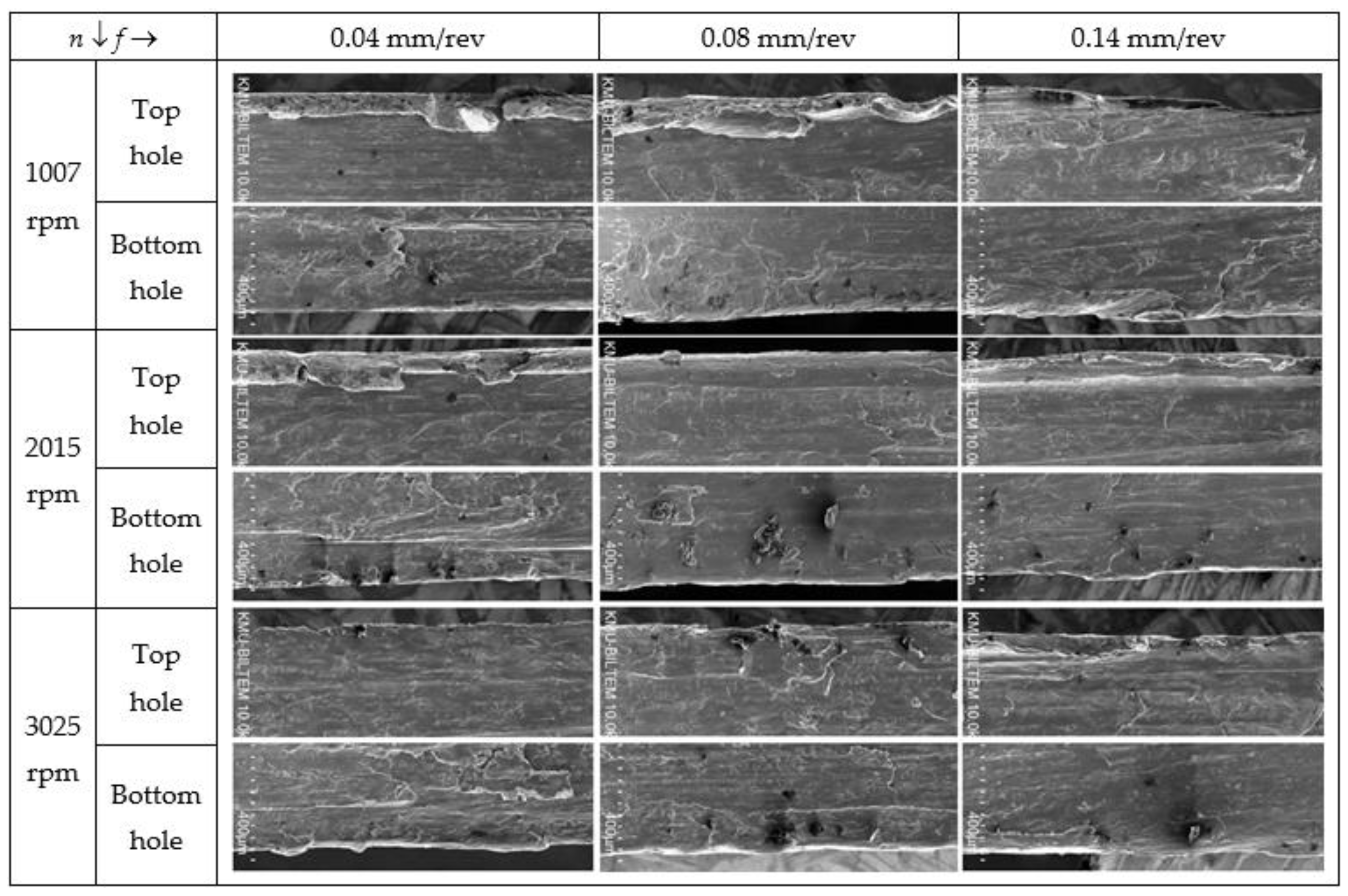
References
- Aamir, M.; Giasin, K.; Tolouei-Rad, M.; Vafadar, A. A review: Drilling performance and hole quality of aluminium alloys for aerospace applications. J. Mater. Res. Technol. 2020, 9, 12484–12500. [Google Scholar] [CrossRef]
- Tolouei-Rad, M.; Aamir, M. Analysis of the Performance of Drilling Operations for Improving Productivity. In Drilling; Tolouei-Rad, M., Ed.; IntechOpen: London, UK, 2021; Available online: https://www.intechopen.com/online-first/analysis-of-the-performance-of-drilling-operations-for-improving-productivity (accessed on 9 May 2021).
- Giasin, K.; Hawxwell, J.; Sinke, J.; Dhakal, H.; Köklü, U.; Brousseau, E. The effect of cutting tool coating on the form and dimensional errors of machined holes in GLARE® fibre metal laminates. Int. J. Adv. Manuf. Technol. 2020, 107, 2817–2832. [Google Scholar] [CrossRef]
- Aamir, M.; Tolouei-Rad, M.; Giasin, K.; Nosrati, A. Recent advances in drilling of carbon fiber–reinforced polymers for aerospace applications: A review. Int. J. Adv. Manuf. Technol. 2019, 105, 2289–2308. [Google Scholar] [CrossRef]
- Giasin, K.; Gorey, G.; Byrne, C.; Sinke, J.; Brousseau, E. Effect of machining parameters and cutting tool coating on hole quality in dry drilling of fibre metal laminates. Compos. Struct. 2019, 212, 159–174. [Google Scholar] [CrossRef]
- Giasin, K. The effect of drilling parameters, cooling technology, and fiber orientation on hole perpendicularity error in fiber metal laminates. Int. J. Adv. Manuf. Technol. 2018, 97, 4081–4099. [Google Scholar] [CrossRef]
- Kurt, M.; Kaynak, Y.; Bagci, E. Evaluation of drilled hole quality in Al 2024 alloy. Int. J. Adv. Manuf. Technol. 2008, 37, 1051–1060. [Google Scholar] [CrossRef]
- Leep, H.R. Influence of cutting fluids on surface finish of holes drilled into aluminium 390. J. Synth. Lubr. 1990, 6, 325–338. [Google Scholar] [CrossRef]
- Bono, M.J. Experimental and Analytical Issues in Drilling; University of Michigan: Ann Arbor, MI, USA, 2003. [Google Scholar]
- Kurt, M.; Bagci, E.; Kaynak, Y. Application of Taguchi methods in the optimization of cutting parameters for surface finish and hole diameter accuracy in dry drilling processes. Int. J. Adv. Manuf. Technol. 2009, 40, 458–469. [Google Scholar] [CrossRef]
- Kushnoore, S.; Noel, D.; Kamitkar, N.; Satishkumar, M. Experimental investigations on thrust, torque and circularity error in drilling of aluminium alloy (Al6061). Am. J. Mech. Ind. Eng. 2016, 1, 96–102. [Google Scholar]
- Uddin, M.; Basak, A.; Pramanik, A.; Singh, S.; Krolczyk, G.M.; Prakash, C. Evaluating hole quality in drilling of Al 6061 alloys. Materials 2018, 11, 2443. [Google Scholar] [CrossRef]
- Islam, M.N.; Boswell, B. Effect of cooling methods on hole quality in drilling of aluminium 6061-6T. In Proceedings of the IOP Conference Series: Materials Science and Engineering, Kuala Lumpur, Malaysia, 12–14 November 2015; p. 012022. [Google Scholar]
- Nouari, M.; List, G.; Girot, F.; Coupard, D. Experimental analysis and optimisation of tool wear in dry machining of aluminium alloys. Wear 2003, 255, 1359–1368. [Google Scholar] [CrossRef]
- Aamir, M.; Tolouei-Rad, M.; Giasin, K. Multi-spindle drilling of Al2024 alloy and the effect of TiAlN and TiSiN-coated carbide drills for productivity improvement. Int. J. Adv. Manuf. Technol. 2021, 1–10. [Google Scholar]
- Aamir, M.; Tolouei-Rad, M.; Giasin, K.; Vafadar, A. Machinability of Al2024, Al6061, and Al5083 alloys using multi-hole simultaneous drilling approach. J. Mater. Res. Technol. 2020, 9, 10991–11002. [Google Scholar] [CrossRef]
- Aamir, M.; Tu, S.; Giasin, K.; Tolouei-Rad, M. Multi-hole simultaneous drilling of aluminium alloy: A preliminary study and evaluation against one-shot drilling process. J. Mater. Res. Technol. 2020, 9, 3994–4006. [Google Scholar] [CrossRef]
- Aamir, M.; Tu, S.; Tolouei-Rad, M.; Giasin, K.; Vafadar, A. Optimization and modeling of process parameters in multi-hole simultaneous drilling using taguchi method and fuzzy logic approach. Materials 2020, 13, 680. [Google Scholar] [CrossRef] [PubMed]
- Aamir, M.; Tolouei-Rad, M.; Giasin, K.; Vafadar, A. Feasibility of tool configuration and the effect of tool material, and tool geometry in multi-hole simultaneous drilling of Al2024. Int. J. Adv. Manuf. Technol. 2020, 111, 861–879. [Google Scholar] [CrossRef]
- Aamir, M.; Tolouei-Rad, M.; Vafadar, A.; Raja, M.N.A.; Giasin, K. Performance Analysis of Multi-Spindle Drilling of Al2024 with TiN and TiCN Coated Drills Using Experimental and Artificial Neural Networks Technique. Appl. Sci. 2020, 10, 8633. [Google Scholar] [CrossRef]
- Batzer, S.; Haan, D.; Rao, P.; Olson, W.; Sutherland, J. Chip morphology and hole surface texture in the drilling of cast aluminum alloys. J. Mater. Process. Technol. 1998, 79, 72–78. [Google Scholar] [CrossRef]
- Sreejith, P.; Ngoi, B. Dry machining: Machining of the future. J. Mater. Process. Technol. 2000, 101, 287–291. [Google Scholar] [CrossRef]
- Giasin, K.; Ayvar-Soberanis, S.; French, T.; Phadnis, V. 3D Finite Element Modelling of Cutting Forces in Drilling Fibre Metal Laminates and Experimental Hole Quality Analysis. Appl. Compos. Mater. 2017, 24, 113–137. [Google Scholar] [CrossRef]
- Al-Tameemi, H.A.; Al-Dulaimi, T.; Awe, M.O.; Sharma, S.; Pimenov, D.Y.; Koklu, U.; Giasin, K. Evaluation of Cutting-Tool Coating on the Surface Roughness and Hole Dimensional Tolerances during Drilling of Al6061-T651 Alloy. Materials 2021, 14, 1783. [Google Scholar] [CrossRef]
- Giasin, K.; Hodzic, A.; Phadnis, V.; Ayvar-Soberanis, S. Assessment of cutting forces and hole quality in drilling Al2024 aluminium alloy: Experimental and finite element study. Int. J. Adv. Manuf. Technol. 2016, 87, 2041–2061. [Google Scholar] [CrossRef]
- Poznak, A.; Freiberg, D.; Sanders, P. Chapter 10-Automotive Wrought Aluminium Alloys. In Fundamentals of Aluminium Metallurgy; Lumley, R.N., Ed.; Woodhead Publishing: Sawston, UK, 2018; pp. 333–386. [Google Scholar]
- Liang, X.; Liu, Z.; Wang, B. State-of-the-art of surface integrity induced by tool wear effects in machining process of titanium and nickel alloys: A review. Measurement 2019, 132, 150–181. [Google Scholar] [CrossRef]
- Buehler. Solutions for Materials Preparation, Testing & Analysis: Don’t Smear It! Avoiding Surface Deformation in Polishing. Available online: https://metallography-matters.buehler.com/2018/09/17/dont-smear-it-avoiding-surface-deformation-in-polishing/#:~:text=To%20prevent%20smearing%2C%20it’s%20best,polishing%20surface%20can%20also%20help (accessed on 6 March 2021).
- Kishawy, H.; Elbestawi, M. Effects of process parameters on material side flow during hard turning. Int. J. Mach. Tools Manuf. 1999, 39, 1017–1030. [Google Scholar] [CrossRef]
- Pawade, R.; Joshi, S.S.; Brahmankar, P.; Rahman, M. An investigation of cutting forces and surface damage in high-speed turning of Inconel 718. J. Mater. Process. Technol. 2007, 192, 139–146. [Google Scholar] [CrossRef]
- Roukema, J.C.; Altintas, Y. Generalized modeling of drilling vibrations. Part II: Chatter stability in frequency domain. Int. J. Mach. Tools Manuf. 2007, 47, 1474–1485. [Google Scholar] [CrossRef]
- Akyüz, B. Effect of silicon content on machinability of AL-SI alloys. Adv. Sci. Technol. Res. J. 2016, 10, 51–57. [Google Scholar] [CrossRef]
- Kamiya, M.; Yakou, T.; Sasaki, T.; Nagatsuma, Y. Effect of Si content on turning machinability of Al-Si binary alloy castings. Mater. Trans. 2008, 49, 587–592. [Google Scholar] [CrossRef]
- Köklü, U. Influence of the process parameters and the mechanical properties of aluminum alloys on the burr height and the surface roughness in dry drilling. Mater. Tehnol. 2012, 46, 103–108. [Google Scholar]
- Ratnam, M. Factors affecting surface roughness in finish turning. In Comprehensive Materials Finishing; Elsevier: Amsterdam, The Netherlands, 2017; Volume 1, pp. 1–25. [Google Scholar]
- Ko, S.-L.; Lee, J.-K. Analysis of burr formation in drilling with a new-concept drill. J. Mater. Process. Technol. 2001, 113, 392–398. [Google Scholar] [CrossRef]
- Choudhury, I.A.; Lawal, S.A. 11.12-Burr Formation in Machining Processes: A Review. In Comprehensive Materials Processing; Elsevier: Oxford, UK, 2014; Volume 11, pp. 283–295. [Google Scholar]
- Zhu, Z.; Guo, K.; Sun, J.; Li, J.; Liu, Y.; Zheng, Y.; Chen, L. Evaluation of novel tool geometries in dry drilling aluminium 2024-T351/titanium Ti6Al4V stack. J. Mater. Process. Technol. 2018, 259, 270–281. [Google Scholar] [CrossRef]
- Mann, J.Y.; Milligan, I.S. Aircraft Fatigue: Design, Operational and Economic Aspects; Elsevier Science: Melbourne, Australia, 2013. [Google Scholar]
- Shanmughasundaram, P.; Subramanian, R. Study of parametric optimization of burr formation in step drilling of eutectic Al–Si alloy–Gr composites. J. Mater. Res. Technol. 2014, 3, 150–157. [Google Scholar] [CrossRef]
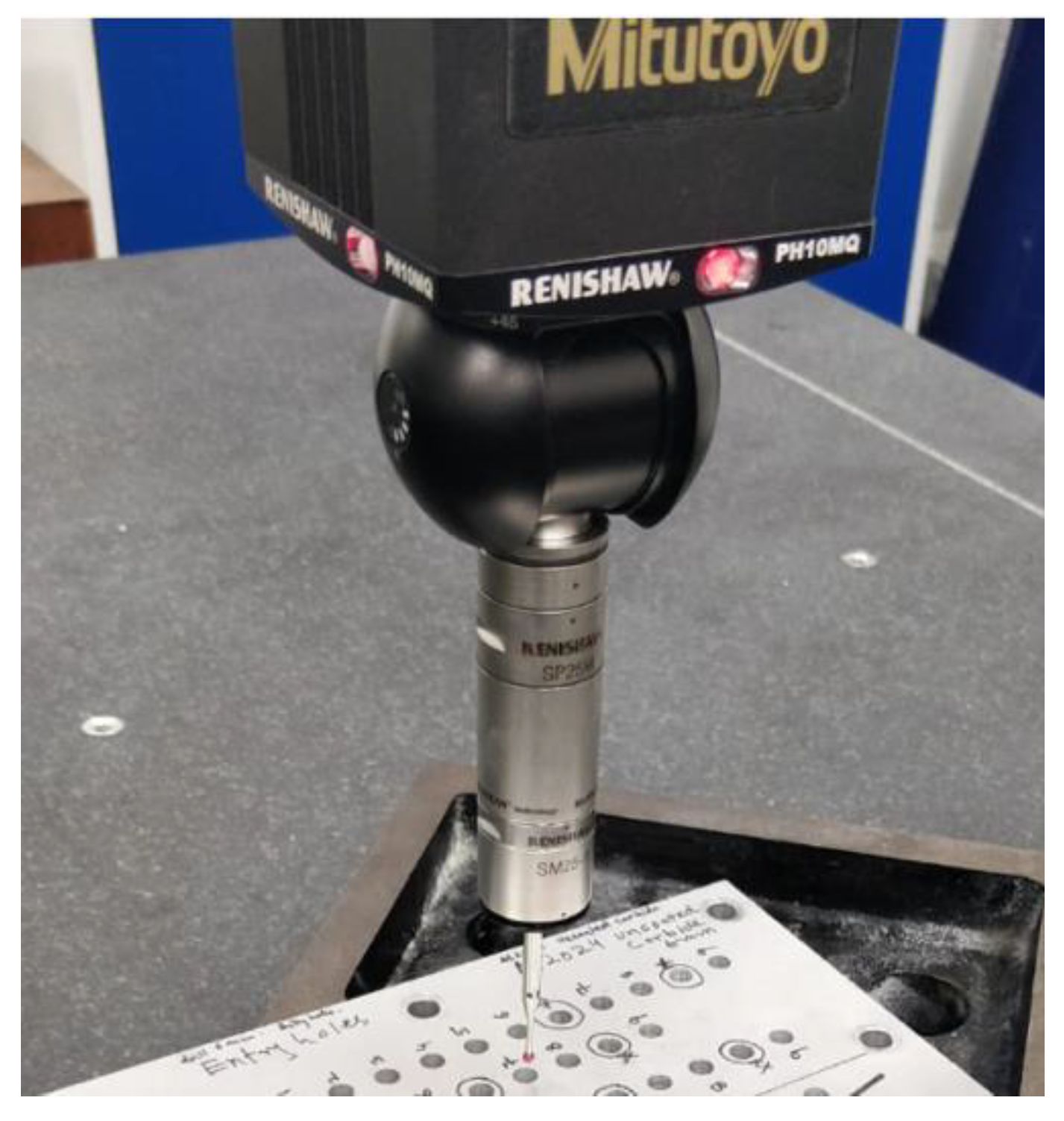
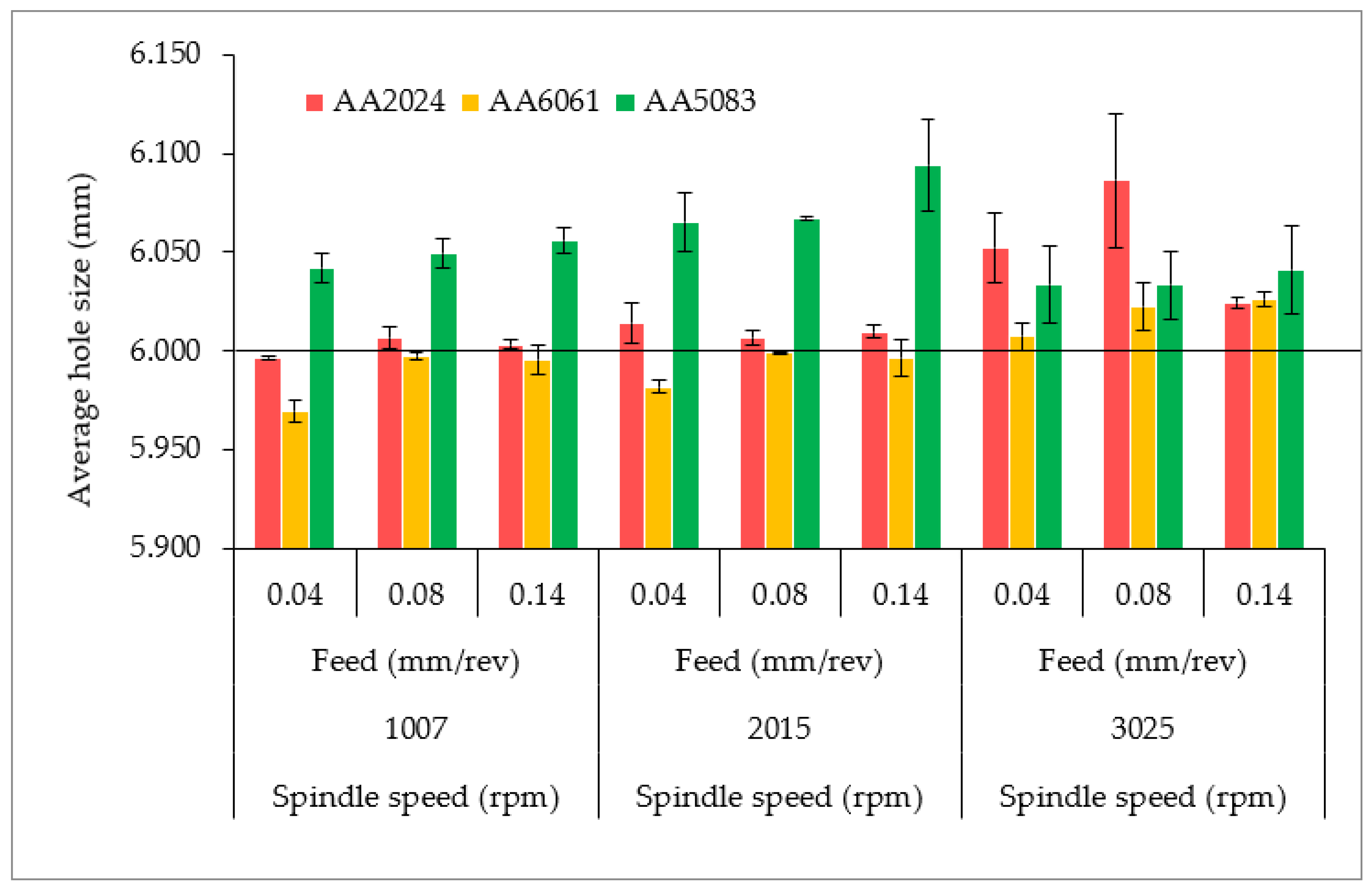


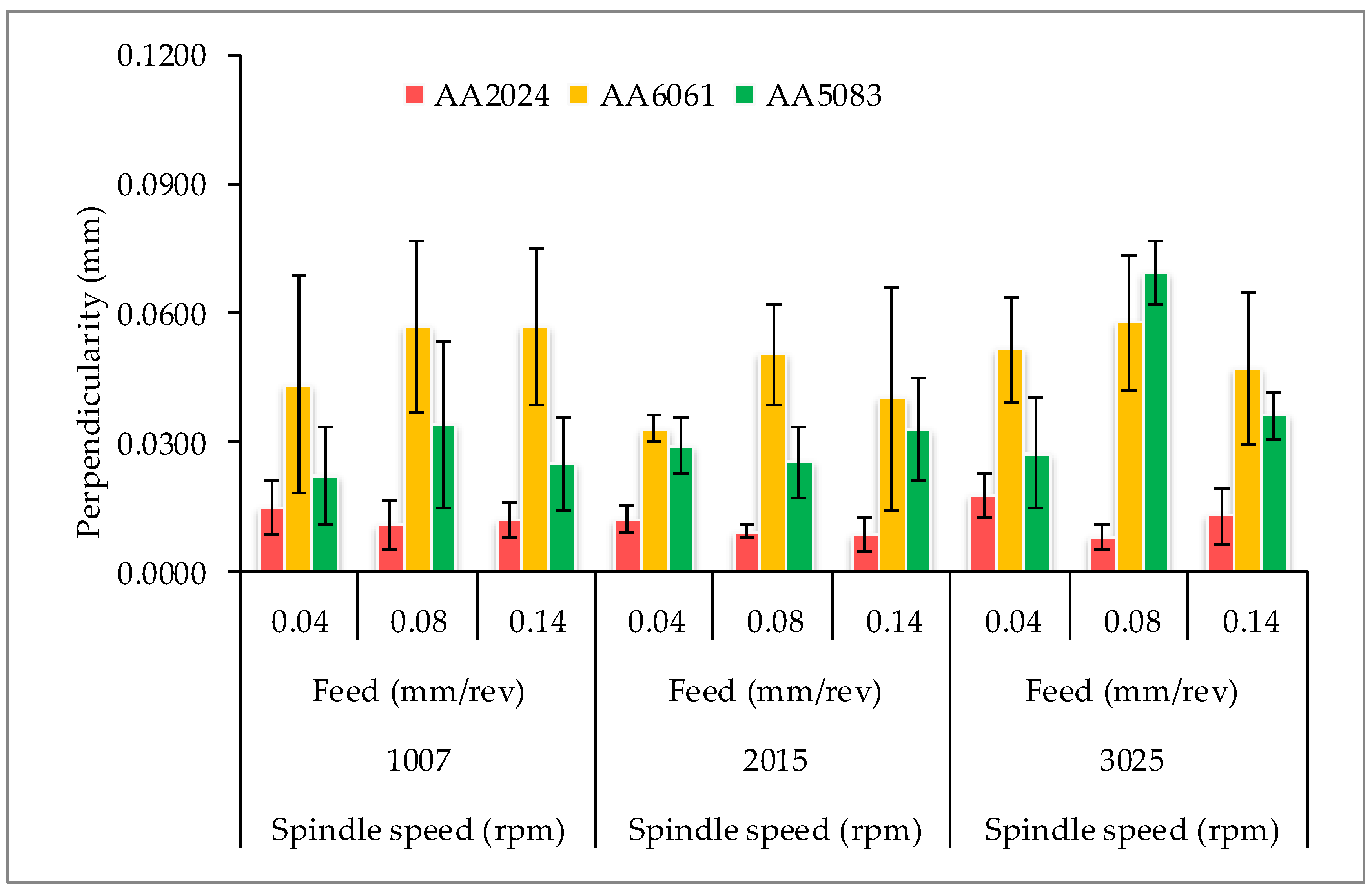
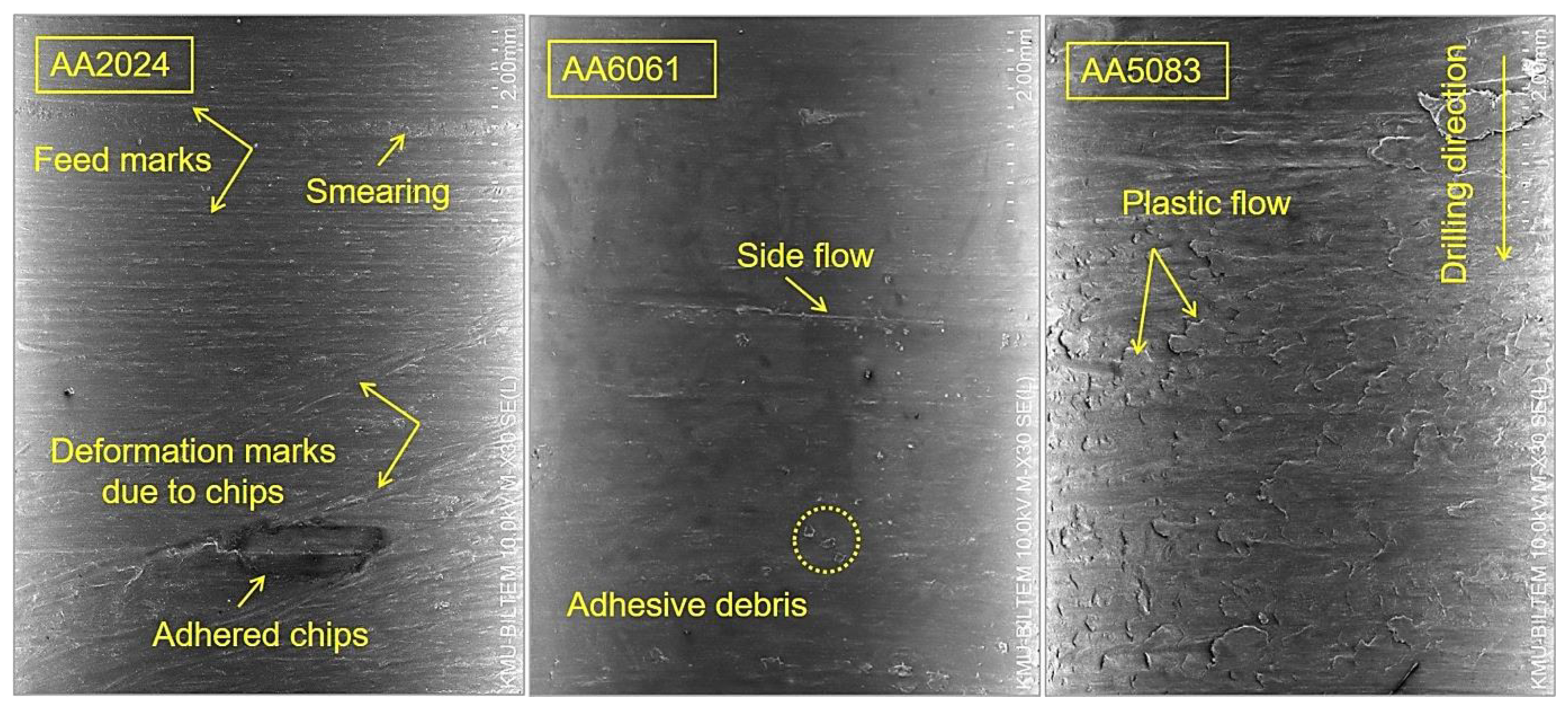

| Element | Composition in wt.% | Properties | Aluminium Alloy | ||||
|---|---|---|---|---|---|---|---|
| AA2024 | AA6061 | AA5083 | AA2024 | AA6061 | AA5083 | ||
| Mg | 1.2–1.8 | 0.8–1.2 | 4.0–4.9 | Machinability | 70% | 50% | 30% |
| Si | 0.5 | 0.4–0.8 | 0.4 | Shear strength (MPa) | 283 | 207 | 190 |
| Mn | 0.3–0.9 | 0.15 | 0.4–1.0 | Ultimate tensile strength (MPa) | 483 | 310 | 317 |
| Ti | 0.15 | 0.15 | 0.15 | Hardness, Vickers | 137 | 107 | 96 |
| Zn | 0.25 | 0.25 | 0.25 | Elongation at break | 18% | 12% | 16% |
| Cu | 3.8–4.9 | 0.15–0.4 | 0.1 | Modulus of elasticity (GPa) | 73.1 | 68.9 | 71 |
| Fe | 0.5 | 0.7 | 0.4 | Hardness, Brinell | 120 | 95 | 85 |
| Cr | 0.1 | 0.04–0.35 | 0.05–0.25 | Thermal conductivity (W/m-K) | 121 | 167 | 117 |
| Al | Balance | Balance | Balance | The average coefficient of thermal expansion (Coefficient from 20 to 100 °C) (µm/m-°C) | 23.2 | 23.6 | 23.75 |
| Specification/Description | ||
|---|---|---|
| Type | Twist drill |  |
| Material | Uncoated carbide | |
| Number of flutes | 02 | |
| Point angle | 140° | |
| Helix angle | 30° | |
| Drill diameter | 6 mm |
| Source | Hole Size | Circularity | Cylindricity | Perpendicularity | ||||
|---|---|---|---|---|---|---|---|---|
| p-Value | Contribution | p-Value | Contribution | p-Value | Contribution | p-Value | Contribution | |
| Model | 0.001 | 96.08% | 0 | 97.06% | 0.024 | 90.24% | 0.009 | 92.60% |
| Linear | 0 | 64.19% | 0 | 54.54% | 0.01 | 47.06% | 0.001 | 81.59% |
| n | 0.007 | 9.71% | 0.804 | 0.16% | 0.046 | 11.35% | 0.122 | 5.12% |
| f | 0.12 | 2.74% | 0.281 | 1.10% | 0.619 | 1.25% | 0.218 | 3.43% |
| Alloy type | 0 | 51.75% | 0 | 53.28% | 0.002 | 34.46% | 0 | 73.04% |
| 2-Way Interactions | 0.012 | 31.88% | 0.002 | 42.52% | 0.066 | 43.18% | 0.521 | 11.02% |
| n × f | 0.386 | 2.33% | 0.389 | 1.73% | 0.218 | 8.89% | 0.779 | 1.61% |
| n × Alloy type | 0.002 | 24.81% | 0 | 29.20% | 0.045 | 19.54% | 0.388 | 4.37% |
| f × Alloy type | 0.134 | 4.74% | 0.007 | 11.59% | 0.086 | 14.75% | 0.328 | 5.04% |
| Error | - | 3.92% | - | 2.94% | - | 9.76% | - | 7.40% |
| Total | - | 100.00% | - | 100.00% | - | 100.00% | - | 100.00% |
Publisher’s Note: MDPI stays neutral with regard to jurisdictional claims in published maps and institutional affiliations. |
© 2021 by the authors. Licensee MDPI, Basel, Switzerland. This article is an open access article distributed under the terms and conditions of the Creative Commons Attribution (CC BY) license (https://creativecommons.org/licenses/by/4.0/).
Share and Cite
Aamir, M.; Tolouei-Rad, M.; Giasin, K.; Vafadar, A.; Koklu, U.; Keeble, W. Evaluation of the Surface Defects and Dimensional Tolerances in Multi-Hole Drilling of AA5083, AA6061, and AA2024. Appl. Sci. 2021, 11, 4285. https://doi.org/10.3390/app11094285
Aamir M, Tolouei-Rad M, Giasin K, Vafadar A, Koklu U, Keeble W. Evaluation of the Surface Defects and Dimensional Tolerances in Multi-Hole Drilling of AA5083, AA6061, and AA2024. Applied Sciences. 2021; 11(9):4285. https://doi.org/10.3390/app11094285
Chicago/Turabian StyleAamir, Muhammad, Majid Tolouei-Rad, Khaled Giasin, Ana Vafadar, Ugur Koklu, and William Keeble. 2021. "Evaluation of the Surface Defects and Dimensional Tolerances in Multi-Hole Drilling of AA5083, AA6061, and AA2024" Applied Sciences 11, no. 9: 4285. https://doi.org/10.3390/app11094285
APA StyleAamir, M., Tolouei-Rad, M., Giasin, K., Vafadar, A., Koklu, U., & Keeble, W. (2021). Evaluation of the Surface Defects and Dimensional Tolerances in Multi-Hole Drilling of AA5083, AA6061, and AA2024. Applied Sciences, 11(9), 4285. https://doi.org/10.3390/app11094285









